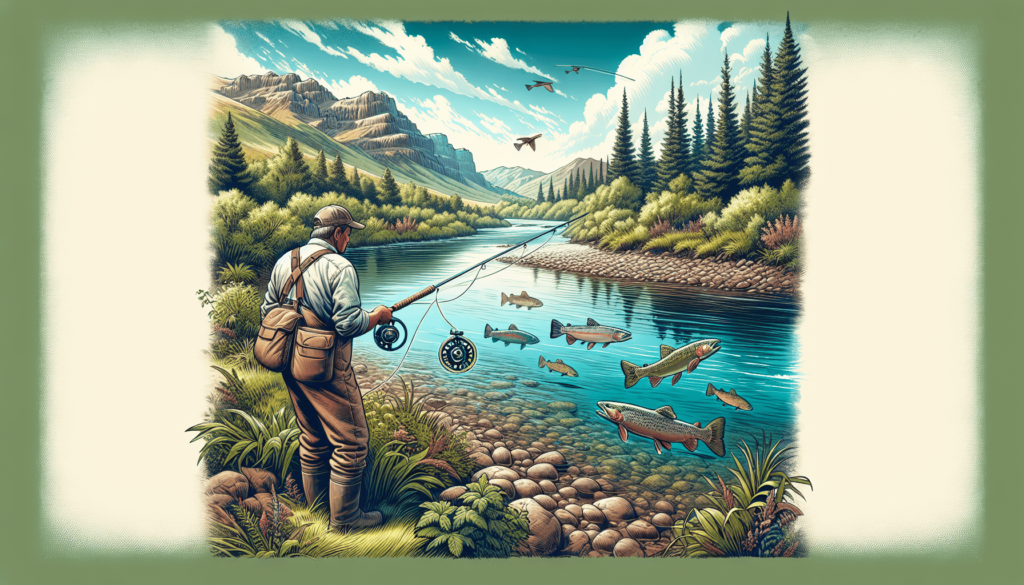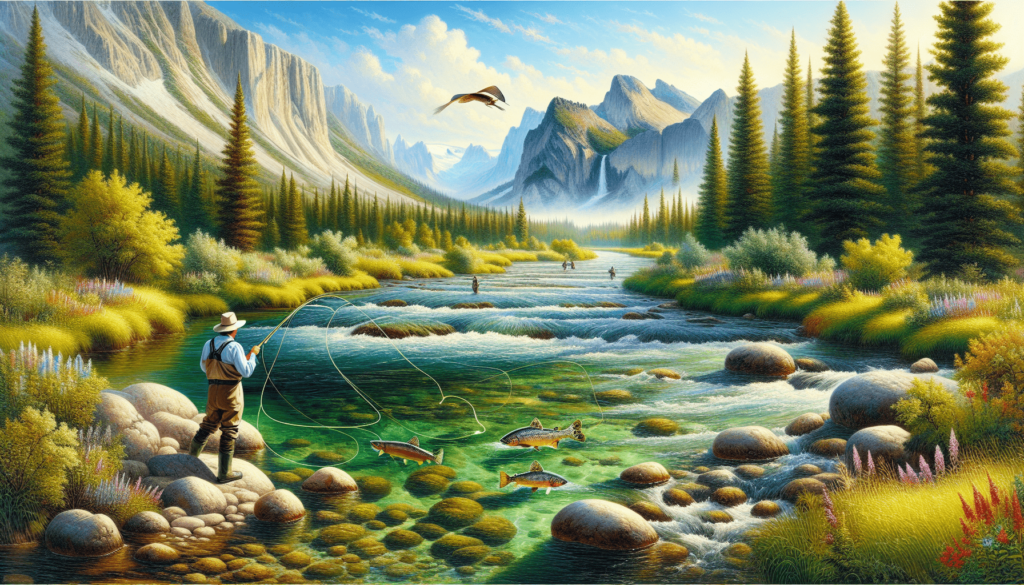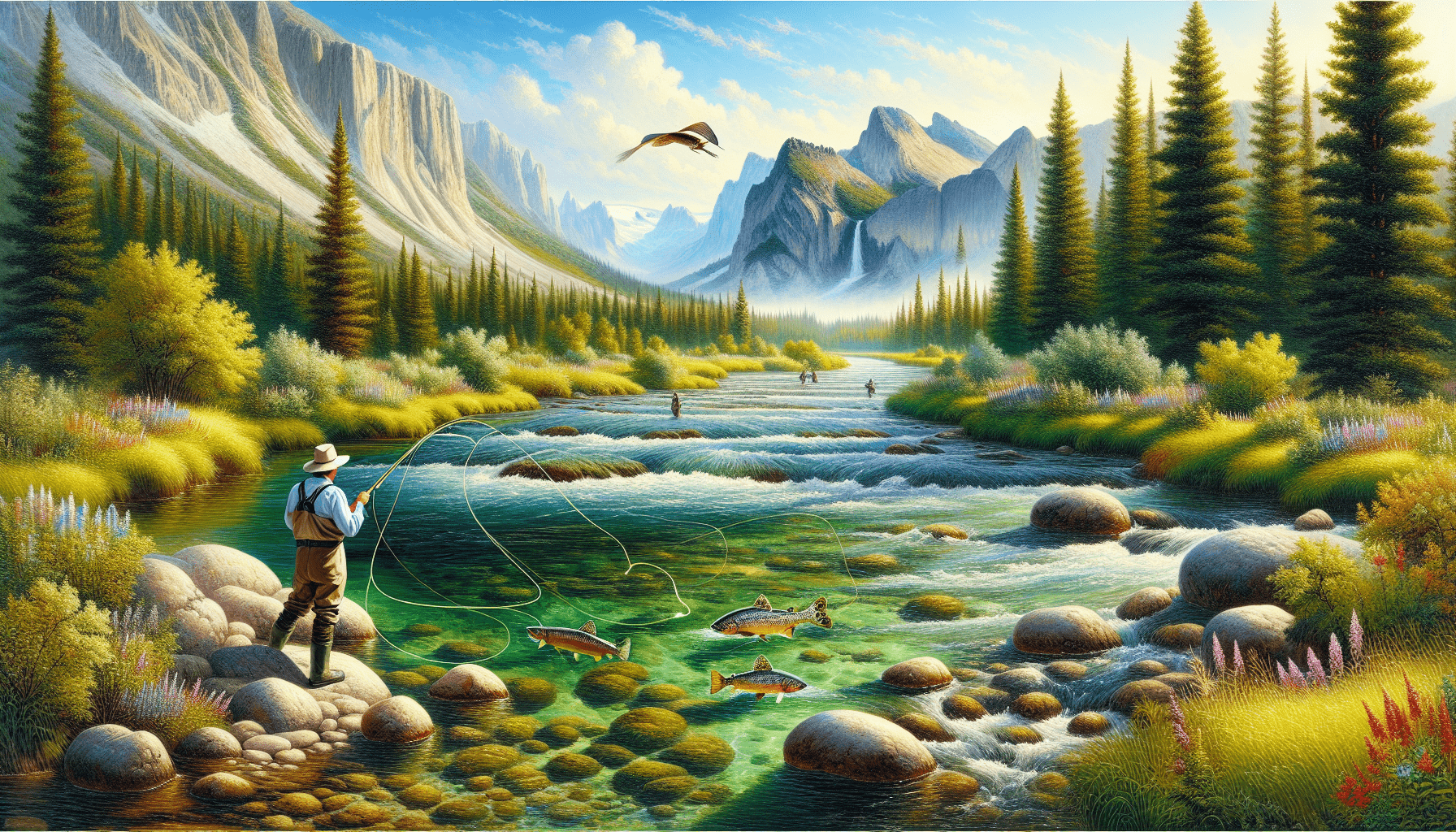Looking to reel in some trophy-worthy trout in the picturesque state of Idaho? Look no further! In this article, we’ll explore the best fly fishing locations that will have you hooked in no time. With its pristine rivers, crystal-clear lakes, and stunning mountain landscapes, Idaho offers anglers a paradise for pursuing their passion. Whether you’re a seasoned fly fishing enthusiast or someone just starting out, you’re in for an unforgettable experience as we guide you to the very best spots in the Gem State. So grab your gear, cast a line, and get ready to discover the ultimate fly fishing destinations for trout in Idaho!

Henry’s Fork
Overview
Located in eastern Idaho, Henry’s Fork is renowned for its excellent trout fishing opportunities. The river stretches around 127 miles and offers a diverse range of fishing experiences, from large meandering sections to fast-paced pocket water. With its stunning scenery and abundant fish population, Henry’s Fork is a favorite among anglers of all skill levels.
Location
Henry’s Fork is located in southeastern Idaho, flowing through Teton and Fremont counties. The river starts from Henry’s Lake and merges with the North and South Forks of the Snake River near Ashton, forming the mainstem of the Snake River.
Best Time to Visit
The best time to visit Henry’s Fork for fly fishing is during the summer months, from June to September. This is when the river experiences peak water levels and the hatches are most active, resulting in plenty of feeding opportunities for the trout. However, fishing in the shoulder seasons of spring and fall can also be productive, as the river sees less angling pressure during these times.
Fish Species
Henry’s Fork is primarily known for its world-class rainbow trout fishery. The river is also home to brown trout, cutthroat trout, and brook trout, providing anglers with diverse fishing opportunities. The average size of the trout in Henry’s Fork is impressive, with fish often exceeding 20 inches in length.
Popular Flies
Some of the popular fly patterns that prove effective in Henry’s Fork include Parachute Adams, Elk Hair Caddis, Pale Morning Dun, Blue Winged Olive, and Rubber Legs Stonefly. These flies mimic the various insects found in the river, such as mayflies, caddisflies, and stoneflies, which are abundant and form a significant part of the trout’s diet.
Silver Creek
Overview
Silver Creek is a unique and highly revered fly fishing destination situated in south-central Idaho. Known for its gin-clear water and challenging trout, the creek offers a one-of-a-kind fly fishing experience. Its picturesque setting and impressive fish population make it a must-visit location for any avid angler.
Location
Silver Creek flows through the heart of Idaho’s Wood River Valley, near the town of Sun Valley. The creek originates from several springs, creating a consistent and relatively stable water flow throughout the year.
Best Time to Visit
While fishing is allowed year-round on Silver Creek, the most productive time to visit is during the summer and fall months. The creek experiences significant hatches during this period, including Tricos, Baetis, Callibaetis, and an assortment of midges. The cooler months of spring and fall offer excellent fishing opportunities as well, but with fewer hatches.
Fish Species
Silver Creek is primarily known for its population of wary and challenging brown trout. Rainbow trout can also be found in the creek, although they are less prevalent. The size of trout found in Silver Creek tends to be smaller compared to other Idaho rivers, with the average fish measuring around 12-16 inches.
Popular Flies
When fly fishing on Silver Creek, popular fly patterns that have proven successful include the Griffith’s Gnat, PMD Sparkle Dun, RS2, Zebra Midge, and Copper John. These flies imitate the various insects found in the creek, such as midges, mayflies, and caddisflies, which form the primary food source for the trout.
South Fork of the Snake River
Overview
The South Fork of the Snake River is a world-class fly fishing destination, coveted for its exceptional trout fishery and breathtaking scenic beauty. Spanning 64 miles, this iconic Idaho river offers a diverse range of fishing opportunities, from alluring riffles to challenging pocket water, making it a favorite among anglers.
Location
The South Fork of the Snake River flows through southeastern Idaho, passing through Caribou-Targhee National Forest and Snake River Range. It starts at Palisades Reservoir and merges with the Henry’s Fork and the North Fork of the Snake River near Menan Buttes, forming the mainstem of the Snake River.
Best Time to Visit
The best time to visit the South Fork of the Snake River is during the summer months, from June to September. This is when the river experiences peak water levels, resulting in prolific hatches and abundant trout feeding opportunities. However, fishing in the shoulder seasons of spring and fall can also be rewarding, albeit with potentially lower water levels and different hatch patterns.
Fish Species
The South Fork of the Snake River is famous for its robust population of native Yellowstone cutthroat trout. Additionally, the river supports healthy populations of brown trout, rainbow trout, and mountain whitefish. Anglers can expect to encounter trout of various sizes, with larger fish in the 16-20 inch range not uncommon.
Popular Flies
When fly fishing on the South Fork of the Snake River, popular fly patterns to consider using include the Parachute Adams, Royal Wulff, Elk Hair Caddis, Pheasant Tail Nymph, and San Juan Worm. These flies effectively imitate the prevalent mayflies, caddisflies, and terrestrials found in the river, enticing the trout to rise to the surface or strike below.
Clearwater River
Overview
The Clearwater River in north-central Idaho is a legendary fly fishing destination, offering pristine waters and a rich diversity of trout species. With its breathtaking scenery and abundant fish population, it is no wonder that the Clearwater River is on the bucket list of many fly anglers.
Location
The Clearwater River starts in the Bitterroot Mountains of Montana and flows through northern Idaho, joining the Snake River near Lewiston. The river is flanked by the Clearwater National Forest, providing a picturesque backdrop for anglers to enjoy.
Best Time to Visit
The best time to visit the Clearwater River for fly fishing is during the spring and fall months. Spring offers ample trout feeding opportunities with hatches of baetis, caddis, and stoneflies. Fall brings spawning runs of steelhead and offers exciting opportunities to catch these migratory fish. However, it is important to check local regulations as steelhead fishing might be limited or closed in some stretches of the river.
Fish Species
The Clearwater River is home to a variety of trout species, including rainbow trout, cutthroat trout, and bull trout. Additionally, the river is famous for its steelhead runs, attracting anglers from around the world. Steelhead are migratory ocean-going rainbow trout that return to the river to spawn.
Popular Flies
When fly fishing on the Clearwater River, popular fly patterns to use include the Adams Irresistible, Elk Hair Caddis, Hare’s Ear Nymph, Woolly Bugger, and Egg Patterns. These flies imitate the various insects and baitfish found in the river, effectively attracting the attention of both resident trout and steelhead.

Big Wood River
Overview
Nestled in the stunning Sawtooth Mountains of central Idaho, the Big Wood River offers a spectacular fly fishing experience amidst breathtaking wilderness. With its diverse fishing opportunities and stunning scenery, the Big Wood River is a must-visit location for any passionate angler.
Location
The Big Wood River flows through Blaine and Lincoln counties in central Idaho. Originating in the Sawtooth National Forest, the river meanders southward, eventually joining the Little Wood River near Shoshone.
Best Time to Visit
The best time to visit the Big Wood River for fly fishing is during the summer and fall months. The river experiences peak water levels during these seasons, resulting in increased insect activity and feeding opportunities for trout. Additionally, the fall sees fish preparing for winter, making them more aggressive in taking flies.
Fish Species
The Big Wood River boasts a healthy population of rainbow trout, brown trout, brook trout, and mountain whitefish. Anglers can target trout of various sizes, from small pan-sized fish to trophy-sized specimens exceeding 20 inches in length.
Popular Flies
Popular fly patterns that have proven successful on the Big Wood River include the Parachute Adams, Stimulator, Prince Nymph, Zebra Midge, and Griffith’s Gnat. These flies imitate the diverse insect life found in the river, from mayflies and stoneflies to caddisflies and midges, attracting the attention of the hungry trout.
St. Joe River
Overview
The St. Joe River in northern Idaho is a hidden gem for fly fishing enthusiasts, offering a secluded and pristine fishing experience. Known for its remote and breathtaking wilderness, the St. Joe River provides a tranquil escape for anglers seeking solitude and abundant trout.
Location
The St. Joe River flows through the scenic St. Joe National Forest in Idaho’s Panhandle region. The river starts near St. Joe Pass and flows southward before joining the Saint Maries River.
Best Time to Visit
The best time to visit the St. Joe River for fly fishing is during the summer and fall months. The river is known for its healthy population of cutthroat trout, and the summer months see these fish actively feeding on a variety of aquatic insects. Fall brings cooler temperatures and stunning autumn foliage, providing a picturesque backdrop for anglers.
Fish Species
The St. Joe River is primarily known for its native Westslope cutthroat trout population. These beautiful and elusive trout thrive in the river’s clear waters and offer a thrilling challenge for fly anglers. Additionally, anglers may also encounter rainbow trout and bull trout in certain sections of the river.
Popular Flies
Some popular fly patterns known to entice trout in the St. Joe River include the Royal Wulff, Caddisfly Patterns, Adams Parachute, Woolly Bugger, and Prince Nymph. These flies mimic the insects that are prevalent in the river, such as mayflies, caddisflies, and stoneflies, effectively attracting the attention of the cutthroat trout.
Kelly Creek
Overview
Kelly Creek is an idyllic and remote fly fishing destination nestled in the Bitterroot Mountains of north-central Idaho. Known for its pristine waters and abundant trout, Kelly Creek offers a peaceful and secluded fishing experience away from the crowds.
Location
Kelly Creek flows through the Clearwater National Forest in north-central Idaho. The creek starts near Kelly Mountain and winds its way through the wilderness, eventually joining the North Fork of the Clearwater River.
Best Time to Visit
The best time to visit Kelly Creek for fly fishing is during the summer months, from June to September. During this time, the creek experiences peak water levels, allowing for easy trout access, and abundant hatches of mayflies, caddisflies, and terrestrials. However, it is essential to come prepared for camping and hiking, as the remote location of Kelly Creek requires a dedication to the wilderness experience.
Fish Species
Kelly Creek is home to a resilient population of native cutthroat trout, including Westslope cutthroat trout and Bull Trout. These trout have adapted to the clear and cold waters of the creek, making them a prized catch for fly anglers. Additionally, Arctic Grayling can also be found in certain sections of the creek.
Popular Flies
Popular fly patterns that have proven successful on Kelly Creek include the Royal Coachman, Elk Hair Caddis, Parachute Adams, Humpy, and Stimulator. These flies imitate the various insects found in the creek, such as mayflies, caddisflies, and stoneflies, attracting the attention of the native cutthroat trout.
Snake River Cutthroat Trout
Overview
Snake River Cutthroat Trout, a subspecies of cutthroat trout, offer an exciting fly fishing experience in Idaho. With its vibrant colors and willingness to take a well-presented fly, the Snake River Cutthroat Trout is a popular target for anglers visiting the state.
Location
Snake River Cutthroat Trout can be found throughout various rivers and streams in Idaho, including the South Fork of the Snake River, Henry’s Fork, and the Snake River itself. They thrive in both large river systems and smaller mountain streams, adapting to various habitat types.
Best Time to Visit
The best time to target Snake River Cutthroat Trout is during the summer months, from June to August. During this time, the trout are actively feeding, and various terrestrial and aquatic insects are prevalent. However, it is important to research specific rivers or streams to determine their individual fishing seasons and regulations.
Fishing Techniques
When targeting Snake River Cutthroat Trout, fly fishing techniques such as dry fly fishing, nymphing, and streamer fishing can all be effective. Dry fly fishing allows anglers to imitate hatching insects on the water’s surface, while nymphing involves fishing subsurface imitations. Streamer fishing, using larger, more lifelike fly patterns, can entice aggressive strikes from these hungry trout.
Licensing and Regulations
To fish for Snake River Cutthroat Trout in Idaho, a valid Idaho fishing license is required. It is important to familiarize yourself with the specific regulations and limits for the waters you plan to fish, as regulations can vary between different rivers and streams. Additionally, catch-and-release practices are encouraged to preserve the populations of these beautiful trout for future generations.
Lost River Range
Overview
The Lost River Range in central Idaho offers a unique fly fishing experience amidst jaw-dropping mountain scenery. This rugged and remote area provides anglers with the opportunity to explore pristine rivers and streams and target various trout species.
Location
The Lost River Range stretches through central Idaho and includes notable river systems such as the Big Lost River, Little Lost River, and Birch Creek. This mountain range is part of the larger Rocky Mountains and offers a true wilderness experience.
Best Time to Visit
The best time to visit the Lost River Range for fly fishing is during the summer and fall months. June to September provides the best fishing conditions, with peak water levels and abundant insect hatches. Additionally, the fall season offers stunning foliage and fewer crowds, providing a serene fishing experience.
Fishing Techniques
Fly fishing techniques such as dry fly fishing, nymphing, and Euro-nymphing are all effective in the Lost River Range. Dry fly fishing allows anglers to imitate surface insects, while nymphing techniques involve presenting subsurface imitations to trout. Euro-nymphing, a specialized nymphing technique using longer and lighter fly rods, can be particularly effective in the rapid currents of mountain streams.
Licensing and Regulations
A valid Idaho fishing license is required to fish in the Lost River Range. Additionally, it is important to review and adhere to the specific regulations and limits for the rivers and streams within the range. Catch-and-release practices are encouraged to preserve the fragile ecosystems and ensure sustainable trout populations.
The Big Lost River
Overview
The Big Lost River, located in central Idaho, offers a challenging and rewarding fly fishing experience for anglers. Known for its crystal-clear waters and technical fishing conditions, this river demands skill and patience to be successful.
Location
The Big Lost River starts in the Sawtooth National Forest and flows through Custer and Butte counties in central Idaho before eventually disappearing underground near Howe. The river flows through a high desert landscape, creating a unique fishing environment.
Best Time to Visit
The best time to fish the Big Lost River is during the summer months, from June to August. During this time, the river experiences peak water levels, providing ample access to the trout habitat, while also receiving a variety of insect hatches for the fish to feed on. It is important to note that weather conditions in the area can change rapidly, so it’s advisable to check local forecasts before venturing out.
Fishing Techniques
Due to the technical nature of the Big Lost River, anglers often find success using light tippet, longer leaders, and smaller fly patterns. Nymphing is a popular technique, using small beadhead nymphs or midge patterns to fish subsurface in the deeper runs and pools. Dry fly fishing can also be productive during hatches, with patterns such as Parachute Adams, Blue-Winged Olives, and Midges working well.
Licensing and Regulations
A valid Idaho fishing license is required to fish in the Big Lost River. It is essential to review and comply with the specific regulations and limits for the river, as they may vary from other fishing locations. Catch-and-release practices are encouraged to preserve the wild trout population and ensure sustainable fishing opportunities for future anglers.
In conclusion, Idaho offers a wealth of exceptional fly fishing destinations for trout enthusiasts. From the renowned Henry’s Fork and Silver Creek to the remote Kelly Creek and Lost River Range, each location provides a unique fishing experience amidst stunning natural beauty. Whether you prefer challenging technical fishing or tranquil solitude, Idaho is sure to satisfy your fly fishing desires. So grab your gear, explore these remarkable rivers and streams, and create lasting memories on the water.
